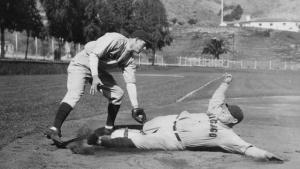
Today, spring on Catalina Island unfolds with subtle signs—green hillsides, intricate wildflowers, and warmer days signaling the shift in seasons. But in the early 20th century, Avalon announced spring’s arrival with grand celebrations—and the return of a beloved team.
From 1921 to 1941 and again from 1946 to 1951, Catalina Island was home to the Chicago Cubs’ spring training. This longstanding tradition brought the Cubs to Avalon and introduced the island to countless baseball fans across the country, leaving a legacy that’s still celebrated today.
The story began in 1919 when businessman William Wrigley, Jr., captivated by Catalina’s beauty, purchased the island. Alongside his wife, Ada, Wrigley invested heavily in its development, envisioning it as a top seaside retreat. His passion for baseball led him to invite his beloved Cubs to train on Catalina, creating a lasting relationship that brought national attention to both the team and the island.
By the mid-1920s, Wrigley built a training field that matched the dimensions of Wrigley Field in Chicago. Soon after, he added a clubhouse that would later become the Catalina Island Country Club, one of Avalon’s most striking landmarks.
Every February, the Cubs’ arrival was a festive event, complete with parades, speeches, and live music. Sports reporters came along to document the team’s stay, including a young broadcaster named Ronald “Dutch” Reagan, who later found fame in a different arena. Photos of Cubs players fishing, exploring the Catalina Bird Park, and experiencing the island’s many attractions appeared in newspapers from coast to coast, showcasing Catalina’s allure. Wrigley even advertised the Cubs’ presence with the tagline: “The Cubs Are Here, You Should Come Too.”
During World War II, Catalina Island was repurposed for military training and as a lookout station, and the Cubs stayed closer to home. But after the war, they returned for spring training until 1952, when the team relocated to Mesa, AZ.
While the Cubs no longer train on Catalina, reminders of those golden years are still visible. Memorabilia from that era can be found at the Catalina Museum for Art & History, and Cubs apparel is available in shops like Island Threadz. Although the original ballfield no longer exists, a plaque commemorates its spot below the Catalina Island Golf Course, and the Catalina Island Country Club still offers a glimpse into the island’s history.
The iconic “W” flag is another lasting symbol of this connection. When Wrigley purchased Catalina and the Wilmington Transportation Company in 1919, he began flying the “W” flag around Catalina Island and Wrigley Field to represent the Wilmington line. Over time, this “W” came to stand for “Win,” becoming a symbol of victory for Cubs fans and a reminder of Catalina’s place in the team’s history.
he began flying the “W” flag around Catalina Island and Wrigley Field to represent the Wilmington line. Over time, this “W” came to stand for “Win,” becoming a symbol of victory for Cubs fans and a reminder of Catalina’s place in the team’s history.
Island locals continue to show their affection for the Cubs, proudly flying the “W” flag at places like Avalon Grille, Mt Ada, Pier 24 and the Catalina Casino. In 2016, when the Cubs won the World Series, celebrations echoed through Avalon, and “Take Me Out to The Ballgame” played on the Catalina Chimes, bringing joy to locals and visitors alike.
In Chicago, the Cubs have honored this special connection with the opening of the Catalina Club at Wrigley Field in 2019, celebrating the years spent on the island and their historic bond.
Catalina Island’s relationship with the Chicago Cubs is a cherished chapter in its story, woven into its heritage, and celebrated by generations of islanders and baseball fans alike.


